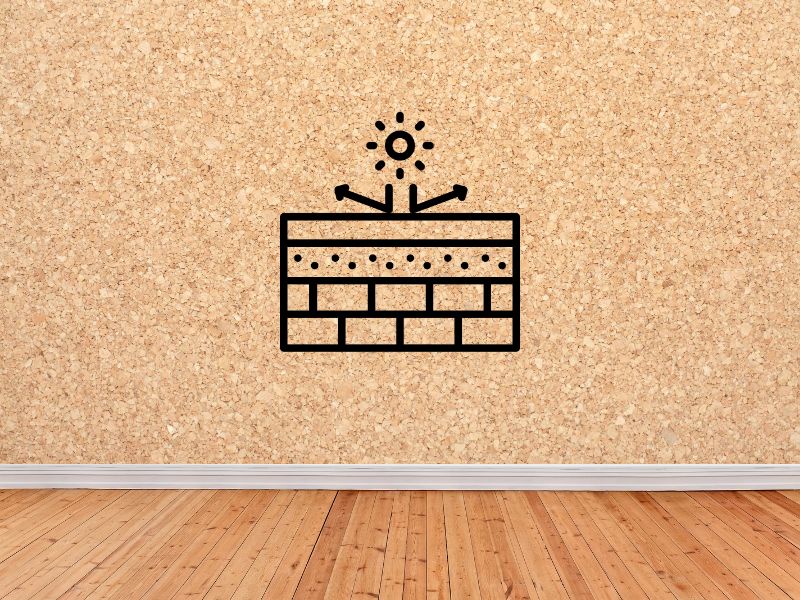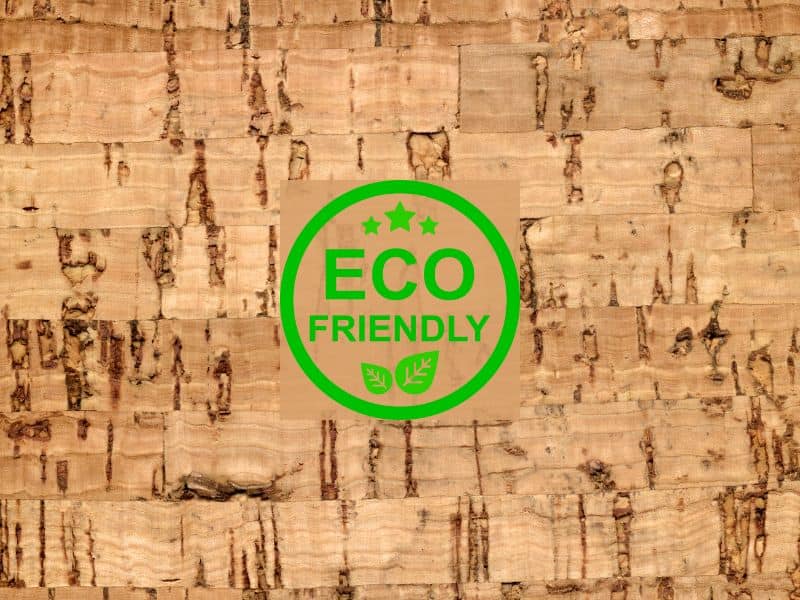Can You Use Cork as a Wall Covering? (Pros and Cons)

Cork is often associated with bulletin board material or sealing wine bottles. However, the building industry has adopted cork as an insulating, soundproofing, and flooring material due to the continued need for more sustainable construction materials.
The question remains, “Can you use cork as a wall covering?”
You can use cork as a wall covering as it’s an excellent sound and thermal insulator. With an NRC of 0.7, cork absorbs up to 70 percent of sound waves, creating a quieter and cozier indoor space. It also has R-values between 3.6 and 4.2 per inch, making it a good thermal insulator to save energy.
In the rest of this article, I’ll discuss the purposes of wall coverings and how cork meets them. I’ll also discuss the pros and cons of using cork as a wall covering. Let’s dive right in!
Purposes of Wall Coverings
Besides their aesthetic value, wall coverings serve a variety of purposes, including:
Thermal Insulation

Wall coverings can play an essential thermal insulation role. Depending on the material, a wall covering can reduce heat gain and loss, decreasing the energy necessary to maintain a comfortable temperature throughout your home.
If you want to enhance your home’s thermal insulation, consider materials with the following features:
- Low bulk density.
- Poor thermal conductivity.
- High R-value per inch.
Cork possesses the above features since it has a low density (0.25 g/cm3), poor thermal conductivity (0.036-0.38 W/mK), and high R-values between 3.6 and 4.2 per inch.
Soundproofing

Wall coverings are an effective way to block sound waves from entering or leaving a room.
More often than not, wall coverings enhance a home’s acoustics by deadening and absorbing sound waves.
By reducing noise between and within rooms, these coverings create a quieter, more peaceful environment ideal for studying or resting.
For an efficient soundproofing wall covering, consider a material with the following:
- High compressibility.
- Low density.
- High Noise Reduction Coefficient (NRC).
Luckily, cork checks all the above boxes. It’s highly compressible with a low density and a high NRC (0.7).
Fire Retardancy
Wall coverings can serve as a fire retardant to protect your home from the spread of flames.
Wall coverings made of certain natural materials like cork are less flammable than some synthetic ones and can be a reliable first line of defense against fires.
Enhancing Design
A wall covering can improve the visual appearance of your space. They can add texture, color, and pattern to a room.
Cork is available in different colors, textures, and patterns that can fit any room’s design.
Moreover, its soft nature makes it easy to apply and remove from walls without damage.
The Pros of Using Cork as a Wall Covering
The following are the pros of cork as a wall covering:
Eco-Friendly and Sustainable

Cork wall covering is your go-to option if you’re eco-conscious.
Cork’s eco-friendly and sustainable nature stems from its harvesting, manufacturing, and use.
Although cork is sourced from the cork oak tree, it’s harvested sustainably without harming the tree or the environment.
The harvesting process involves making vertical and horizontal incisions through the tree’s bark before stripping the bark off by hand.
Once the bark is removed, the tree is left to regenerate another layer of bark within 9-12 years before the next harvesting.
Moreover, processing cork is an easy process that doesn’t consume much energy or incorporate toxic materials. Therefore, the process exhibits low embodied energy, making cork one of the greenest building materials.
Excellent Thermal Insulation
Cork is an excellent thermal insulator thanks to its high R-value and poor thermal conductivity.
With a high R-value ranging from R-3.6 to R-4.2, cork offers excellent thermal resistance, ideal for a wall covering.
Coupled with its poor thermal conductivity, cork wall coverings help maintain a comfortable indoor temperature throughout the year. Consequently, this reduces your demand for heating and cooling.
Since heating and cooling are responsible for 55 percent of household energy use, you save a lot by using a cork wall covering.
Excellent Soundproofing
Cork is an ideal wall covering if you live in a noisier neighborhood or want to minimize noise between rooms.
Cork comprises 50% air – science states that air is a poor sound conductor because its molecules are not in continuous contact. Therefore, the air particles within cork cells absorb and dampen sound waves, making cork an excellent soundproofing material.
What’s more, cork has a high Noise Reduction Coefficient (NRC) of 0.7, which is higher than other wall coverings, even some acoustic panels.
It’s also interesting to note that cork’s compressibility lowers the speed of sound since sound travels faster in rigid materials. However, you’ll not notice this while sitting in your living room.
Fire Retardancy
Cork has weak combustion properties. Thus, it’s safe to use in homes since it can resist flames and minimize fire damage in the event of a house fire.
Cork’s excellent fire retardancy makes it an ideal wall covering if you want reliable protection against fires.
The Cons of Using Cork as a Wall Covering
It’s Expensive

Cork is pricier than other materials like fiberglass and sheep’s wool.
In terms of pricing, cork costs between $3 and $10 per square foot.
On the other hand, sheep’s wool and fiberglass costs between $1.10 and $3.10 and $0.88 and $1.64 per square foot, respectively. Therefore, you’ll pay more to cover your wall with cork than using fiberglass or wool to cover the same wall size.
The high cost of cork is based on the fact that the material is harvested periodically (after nine years) and requires skilled harvesters.
It’s Easily Damaged
cork‘s soft nature is a double-edged sword; while it’s useful for soundproofing, it also makes cork vulnerable to damage.
For instance, it’s easy to pierce cork wall coverings, and your cork wall covering can also get damaged by fingernails and pets like cats scratching it.
A point worth mentioning is that although cork is impermeable due to the presence of suberin, it shouldn’t be exposed to water for long.
According to the Society of Wood Science and Technology, exposing cork to water or moisture for a long time increases its absorption kinetics. Therefore, your cork wall covering risks developing water marks and mildew if exposed to water for a long period.
Ensure your home’s indoor relative humidity doesn’t exceed 50% for safety. Beyond this point, the cork starts absorbing moisture, lowering its rigidity.
Expansion and Contraction
Cork is highly elastic; it expands and contracts with temperature and humidity changes.
Such a situation can stress the entire wall, creating gaps between the cork wall covering and the wall.
You can solve this problem by sealing your cork wall covering with wax or polyurethane sealants before installation.
Moreover, ensure at least a one-inch expansion room in every direction to allow the cork to expand and contract.
Final Thoughts
Although cork is a great choice as a wall covering due in part to its sustainable and insulating properties, you should be aware of its drawbacks.
The material is expensive, prone to damage, and expands and contracts with temperature and humidity changes.
At the end of the day, weigh the pros and cons to determine if cork wall covering meets your needs.
Besides cork, you might also want to consider recycled plastic insulation. However, before going that route, is it really worth it? Check out our article about recycled plastic insulation to find out.







